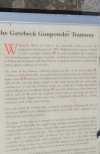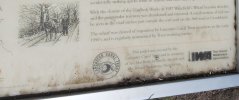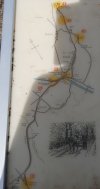Tramway system
A network of tramlines existed within the works by 1881, for a tramline is mentioned in the official report into the explosion of the northern press house in that year (Expense Magazine, section 6.2.3 above). However, the date that tracks were first laid is unclear. The Gatebeck Tramway connecting the factory to Crooklands Wharf and Milnthorpe Station was built in 1875 to a gauge of 3 feet 6 inches (1.07m), opening in January 1876 (section 6.2.8 above). According to Tyler, the internal tram network was built to a narrower gauge. If correct, this suggests that the two parts of the system were laid at different times, with the internal lines probably the earlier. Tyler’s evidence for different gauges is unconvincing, particularly because there is no evidence on any of the maps for transfer sidings (section 4.2 above), but it is nevertheless still feasible that Gatebeck had an internal tram system by the late 1860s or early 1870s since Wakefield’s local competitors were all constructing tram networks around this time. Part of a probable wooden sleeper, apparently in situ, was observed during survey circa 14.5m south of the glazing house. Its dimensions are circa 0.14m wide by at least 1.39m long; such a length would be consistent with a track gauge of 1.07m.
The earliest surviving record of the track plan is the 1896 OS map (Fig 138), which depicts a complex network of lines around the works. However, the present report has found evidence that the map omits parts of the network, namely short spurs out from the expense magazine to the two press houses and possibly another in the vicinity of the mixing house (section 6.2.3 above). Comparison with the 1911 OS map (Fig 139) suggests minor additions and changes were made to the network over the next 15 years, most no doubt intended simply to ease the transfer of materials between buildings, but at least one – the creation of a dedicated spur to the incorporating mills and the shortening of the previous route past the large corning house and glazing house to end at the latter building – was presumably undertaken because of safety considerations (Glazing House, section 6.2.3 above). Although not recorded cartographically, the present investigation has produced evidence that when the small corning house was reconstructed between 1923 and 1931, the spur to the northern press house was extended across the river to replace the existing spur that approached the building from the east (Small Corning House, section 6.2.3 above). The track was lifted when the works closed, and although a number of rails lie scattered about the works (some upended and stuck into the ground north of boiler house 8 for example, presumably as fence posts) there is little evidence of the permanent way apart from bridge abutments where the lines intersected watercourses. The most impressive of these abutments lie on the spur out to the expense magazine and press houses where it crosses the pre-gunpowder mill leat (Fig 103) and beck, but a number of smaller abutments survive along the banks of the beck within both Millbrook and Gatebeck Caravan Parks.




